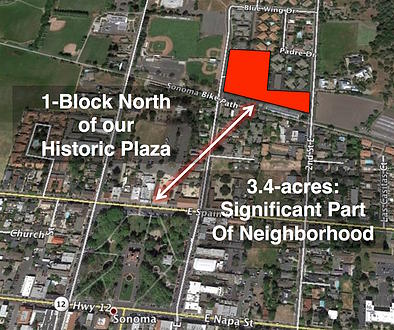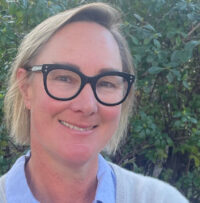After a three-hour Study Session meeting of Sonoma’s Planning Commission last night, Ed Routhier and his development team at Caymus Capital were told in no uncertain terms that their current proposal for housing, a hotel, 112-seat restaurant and swim club was unacceptable for the Mixed Use parcels across the street from Arnold Field and Sonoma Patch.
The project, which spans parcels stretching from 1st East to 2nd Street East, was reviewed by City Staff and the Commission before what most said to be was the largest crowd of the public in memory at attendance at a Planning Commission meeting. Every seat in the meeting room was filled, and the crowd packed the ante-chamber to its capacity.
After a review of the Staff Report by Sonoma’s Planning Director David Goodison, Ed Routhier stepped to the lectern to present his development proposal. He introduced himself as new to the development “game” and as the former owner of a company providing services to the hearing impaired and as living right across the street from this project site. Given 15 minutes for his presentation by Commission Chair Robert Felder, the bulk of Routhier’s comments focused on his project’s projected financial benefits to Sonoma. He displayed a series of charts displaying the economic benefits of a hotel vs. housing and made a passionate case that Sonoma’s future demands the most profitable use of the parcels in question, calling the City of Sonoma “a corporation” that needs to make money. He was followed briefly by JJ Abbodeely, introduced as a partner in the development project, who largely reiterated Routhier’s comments. Finally, the project architect, left with only a couple of minutes, quickly reviewed the layout of the proposed development.
Chairman Felder then opened the meeting to public comment, explaining that each speaker would have three minutes to make comment. First to the microphone was Larry Barnett, former Mayor and City Councilman. Barnett led the unsuccessful effort to limit hotel development in Sonoma called Measure B in 2013, which lost by only 124 votes. In pointed remarks, he noted that Routhier was in fact no novice in real estate, and that his company Caymus Capital proudly explains on its website its record of taking advantage of the 2008 housing collapse to purchase distressed and foreclosed property and thereby generating high profits for its investors. He decried the view expressed by a member of the development team to make Sonoma “an economic powerhouse,” objected to the money-oriented view of Sonoma as a business instead of a community, and said his “BS-detector has been flashing red” as he listened to the development team’s presentation.
Barnett was followed by a succession of speakers, many of the them residents of the neighborhood, who largely condemned the proposal and identified their concerns. Among them was Sam Taylor, President of the North of the Mission Tenants Association, which he noted was ironically formed in 1999 when the Rosewood Hotel development was proposed on land above Mountain Cemetery. He read a statement detailing Association concerns about the inadequacy of a traffic analysis, the height and scale of the project, inadequate parking, and a hotel too large for the location.
Kelso Barnett (no relation to Larry Barnett) then spoke against the proposal, noting it’s lack of “small-scale compatible uses”, language taken from Sonoma’s Development Code. “It’s not downtown” he added, and has no major arterial or collector streets to accommodate traffic. Finally, he presented a 3-D video “fly-over” to illustrate what he termed the inappropriately large “massing and scale” of the proposed project.
While a few speakers arose to speak in favor of the project, the vast majority expressed objection. These included Linda Currotto, who mentioned bike path crossing safety; Richard Peters, a direct neighbor objecting to the creation of a “walled-in community”; Tom Sheehan, who asked about water; and Jack Wagner, who raised issues about affordable housing. The two owners of two adjacent hospitality businesses, The Cottage Inn and The Bungalows, each expressed concerns about cars, traffic and street atmosphere impacts.
Jim Bohar, focusing on historical preservation, noted that the Historic Zone development must be consistent with the historical character of the neighborhood; Vic Conforti urged the developer to go back to his original fully-residential plan and to make the units smaller; new resident Dana Hunter expressed support for the projects economic benefits, but said he was not sure if the location was right; AJ Reibli expressed enjoyment of the weekday quiet of the neighborhood, but was concerned about increased bike path user/auto interactions, and he noted “baseball season has not even started yet.”
Robert O’Malloran was glad to see all the public participation and voiced worries about traffic on 1st Street East. Fred Allebach pointed out the language in the General Plan speaking to matters of “social equity” and urged the Commission to include that intent in its deliberations. Brian Larson, describing himself as a personal friend of Ed Routhier, spoke highly of Routhier’s devotion to Sonoma. David Eichar expressed dismay over the requested parking exceptions, and said “the city is not for sale.” Patty Dafern suggested “story poles” be erected to provide a visual impression of density and height issues. Frank Kelly opined that the inclusion of a hotel is “not appropriate.”
The Public Hearing was closed, and the project then received the attention of the Planning Commissioners. Beginning was Bill Willers, former Chair of the Commission. Willers set the stage for the commission’s direction by strenuously objecting to the use of this Mixed Use parcel for a hotel, which he said he would never approve. Like most members of the public, he expressed concerns about the intent of the project and a preference for use of the properties as a housing opportunity.
Willers was followed in succession by Commissioners Chip Roberson, who said the project ” does not meet the definitions in the General Plan for Mixed-Use; James Cribb, who posed a series of questions about zoning changes and whether the project could be viable; Ron Wellander, who focused on context and compatibility with neighbor’s as well as traffic, scale and size; Mark Hannevold, who bothered by all the exceptions needed for approval, urged thinking in terms of this project’s effect on 3-4 generations in the future; and Chair Felder, who thanked the public for its courtesy and went on to address his concerns about the scale, massing, height and compatibility with the neighborhood, saying “the hotel is too large” and addressing the developer “you have a lot of homework to do.”
Routhier was given a few minutes to further address the commission, clearly searching for an indication of what might be acceptable, including reducing the size of the hotel and adding more housing. The commission, lacking any other formal proposal from the developer to review, largely deferred that question, and the Chair moved on to the next agenda item.






Be First to Comment